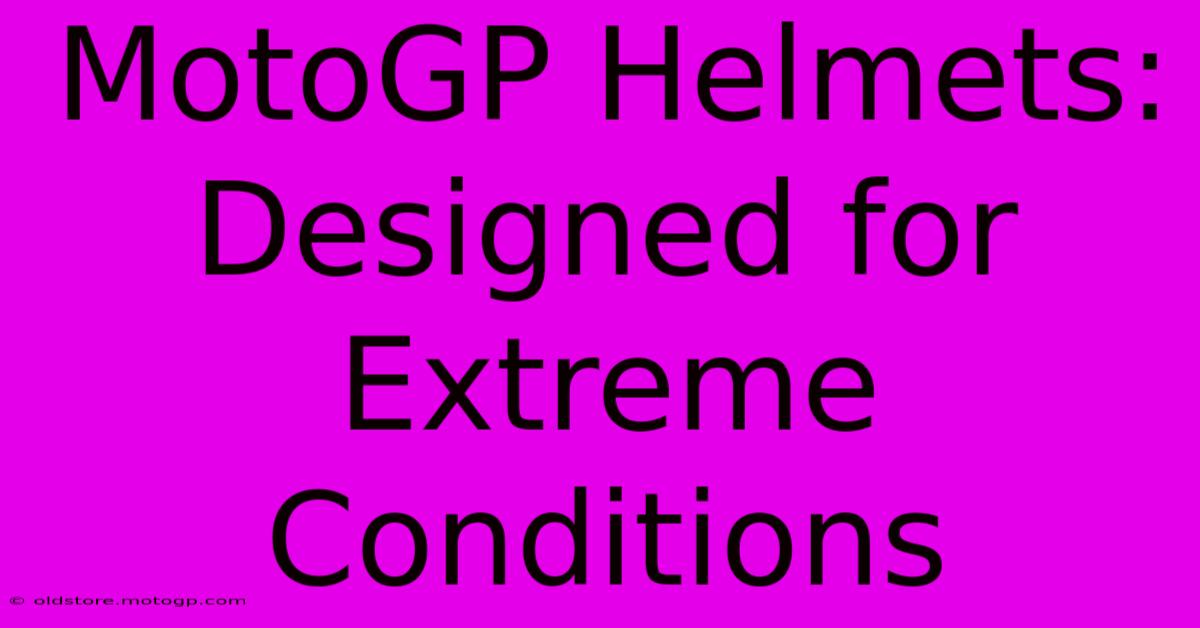MotoGP Helmets: Designed For Extreme Conditions

Table of Contents
MotoGP Helmets: Designed for Extreme Conditions
MotoGP racing pushes the boundaries of human and machine capabilities. Speeds exceeding 200 mph, intense cornering forces, and the ever-present risk of crashes demand equipment that can withstand extreme conditions. Nowhere is this more critical than in the design of MotoGP helmets. These aren't just helmets; they're sophisticated pieces of engineering designed to protect riders from devastating impacts.
The Ultimate in Head Protection: What Makes MotoGP Helmets Different?
Standard motorcycle helmets offer a degree of protection, but MotoGP helmets operate in a different league. The differences are significant and stem from the unique demands of the sport:
1. Advanced Shell Construction:
- Materials: MotoGP helmets primarily utilize carbon fiber and advanced composites. These materials are exceptionally lightweight yet offer superior impact absorption compared to fiberglass or polycarbonate shells found in many consumer helmets. The precise weave and layering of these materials are meticulously engineered to distribute impact forces effectively.
- Shell Design: The aerodynamic design is crucial. Helmets are shaped to minimize wind resistance and turbulence at high speeds, contributing to rider stability and reducing neck strain. Computational Fluid Dynamics (CFD) plays a huge role in this design process.
2. Enhanced Impact Absorption:
- Multi-Density EPS Liner: The inner lining of the helmet is typically made of multiple densities of Expanded Polystyrene (EPS). This allows for graduated impact absorption – softer layers for lower-speed impacts and denser layers for higher-speed collisions.
- Advanced Shock-Absorption Technologies: Some manufacturers incorporate proprietary technologies designed to further enhance impact absorption and reduce rotational forces to the head and neck, minimizing the risk of concussion.
3. Superior Visibility and Communication:
- Wide Field of Vision: MotoGP riders need maximum peripheral vision to anticipate track conditions and other racers. Helmets are designed with exceptionally wide eye ports, often exceeding those found in standard helmets.
- Tear-Off Systems and Pinlocks: Racing conditions can be unpredictable. Tear-off visors allow riders to quickly clear away dirt, rain, or debris, while Pinlock inserts prevent fogging in humid conditions, maintaining clear visibility at all times.
- Integrated Communication Systems: These systems are essential for rider-to-team communication, enabling real-time feedback and strategic adjustments during the race. These are seamlessly integrated into the helmet design, minimizing interference and maximizing comfort.
4. Customization and Fit:
- Custom-Fit Shells: Many top riders have custom-fitted shells molded to their specific head shape for optimal comfort and secure fit. This level of personalization is critical for maintaining stability and minimizing distractions at high speeds.
- Interior Liners: Interior liners are designed to be comfortable, breathable, and easily replaceable for hygiene and customization. Different liner options are available to adjust the fit further.
Beyond Safety: The Importance of Aerodynamics and Weight
While safety is paramount, aerodynamic performance is crucial in MotoGP. The helmet's shape and design influence rider stability, particularly at high speeds and through corners. Minimizing weight is also crucial; every gram saved reduces rider fatigue and improves handling.
The Future of MotoGP Helmets
The quest for continuous improvement never stops. Research and development constantly push the boundaries of helmet technology. Expect to see even more advanced materials, enhanced impact absorption systems, and improved communication technology in future generations of MotoGP helmets. The pursuit of safety and performance remains at the forefront.
Keywords: MotoGP helmets, motorcycle helmets, racing helmets, carbon fiber helmets, helmet safety, advanced helmet technology, impact absorption, aerodynamic helmets, head protection, racing gear, motorsports equipment, custom helmets, MotoGP safety, rider safety.
This article uses a variety of keywords related to MotoGP helmets and their design, ensuring it's optimized for search engines while maintaining readability and engaging content. The use of headings, bold text, and bullet points further enhances readability and SEO.

Thank you for visiting our website wich cover about MotoGP Helmets: Designed For Extreme Conditions. We hope the information provided has been useful to you. Feel free to contact us if you have any questions or need further assistance. See you next time and dont miss to bookmark.
Featured Posts
-
Moto Gp Tracks Accessibility For All
Feb 24, 2025
-
Moto Gp Crash Can It Be Prevented
Feb 24, 2025
-
Moto2 The Secrets Behind The Specs
Feb 24, 2025
-
Conquer Cota Parking Lot R Hacks
Feb 24, 2025
-
Moto Gp Horsepower Beyond Your Wildest Dreams
Feb 24, 2025
